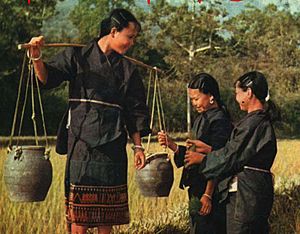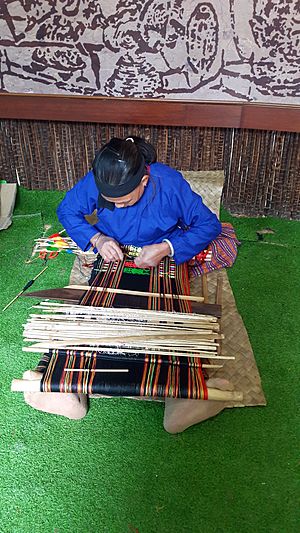Hlai people facts for kids
| 黎族 Li, Lizu |
|
|---|---|
 |
|
| Total population | |
| 1,463,064 (2010) | |
| Regions with significant populations | |
| Hainan, Guangdong and islands in the South China Sea | |
| Languages | |
| Hlai languages, Jiamao, Hainanese and Mandarin | |
| Religion | |
| Animism, Theravada Buddhism | |
| Related ethnic groups | |
| Other Tai–Kadai peoples and populations from Mainland Southern China |
| Hlai people | |||||||||
|---|---|---|---|---|---|---|---|---|---|
| Chinese | 黎 | ||||||||
| Literal meaning | [phonetic] | ||||||||
|
|||||||||
| Alternative Chinese name | |||||||||
| Chinese | 黎族 | ||||||||
| Literal meaning | Li Ethnicity | ||||||||
|
|||||||||
The Hlai, also known as Li or Lizu, are a group of people who speak Kra–Dai languages. They are one of the 56 ethnic groups officially recognized by the People's Republic of China. Most Hlai people live off the southern coast of China on Hainan Island. They are the largest minority ethnic group there. The Hlai are divided into five main groups: Qi (Gei), Ha, Run (Zwn), Sai (Tai, Jiamao), and Meifu (Moifau). Each group has its own special culture and traditions.
Contents
What Are the Hlai People Called?
The name "Li" (黎) comes from the Chinese way of writing their native name, which is Hlai. In ancient times, during China's Sui Dynasty, their ancestors were called Lǐliáo. This was a general term for many non-Han Chinese groups in Southern China. The name "Li" was first written down during the Later Tang period (923–937 CE). Sometimes, the Hlai are also known as the "Sai" or "Say."
A Look at Hlai History
Scientists believe the Hlai languages first came from the Leizhou Peninsula. They think the Hlai people moved across the Hainan Strait to Hainan Island about 4,000 years ago. Early records show the Li people lived along the coast, from northern Vietnam to west of Guangzhou. Their names were later changed to the Chinese family name "Li." The first time "Li" was used to describe an ethnic group was during the Han dynasty.
Hlai People and Ancient Dynasties
In the 3rd century, old writings mentioned people called Lǐ who lived south of Guangzhou. They lived in villages without walls and would hide in the mountains if there was trouble. They didn't have kings or rulers. In the early 6th century, the Liang dynasty had conflicts with the Li people. During the Tang dynasty, the Li people in northern Vietnam had a special status. They paid only half the taxes that other people did. By the 11th century, records no longer mentioned the Li people living on the mainland.
Hlai Life on Hainan Island
The Chinese government didn't directly control the mountains of Hainan until the 1950s. By the 11th century, Chinese records show that Hlai people lived near Chinese settlements and paid taxes. By the mid-17th century, most areas of Hainan that were good for farming were settled by Han Chinese. The Hlai people then focused on providing products from the mountains.
Around 1700, the Qing dynasty took control of Hainan again. New merchants came to Hainan, which caused problems for the Hlai's way of life. This led to protests in 1766.
Hlai During World War II
During the Japanese occupation of Hainan (1939–1945), the Hlai people faced many difficulties. This was especially true in western Hainan because they resisted the Japanese. Hlai villages were often attacked by Japanese soldiers. In just four towns, the Japanese killed more than 10,000 Hlai people.
The Hlai were also treated harshly by the Nationalists (another Chinese political group) because they supported the Chinese Communist Party (CCP). Nationalist forces killed many Hlai people. Because the Hlai sided with the CCP during the Chinese Civil War, the government of the People's Republic of China now views them favorably.
Hlai Language and Communication
The Hlai people speak Hlai languages, which are part of the Kra–Dai language family. However, most Hlai people can also understand or speak Hainanese and Standard Chinese. The Jiamao language, spoken by the Sai subgroup, is quite different from the languages spoken by other Hlai groups.
A report from the Qing dynasty in 1756 said that the Hlai people did not have their own writing system.
Hlai Culture and Traditions
In Hlai society, women could become important leaders. In 1171, a Hlai woman named Wang Erniang was given a special title by the Song court. She was made a commander-general over 36 ethnic groups in the south. She was a very wealthy leader who was good at keeping order among her people. The Song dynasty would send their orders through her to non-Chinese people in the south. Her daughter and then another daughter later took over her position.
Hlai women have a custom of tattooing their arms and backs after they reach a certain age. The Hlai also play traditional wind instruments called kǒuxiāo and lìlāluó. Some Hlai people in Wenchang have blended in with the local population and now identify as Hainanese.
Hlai Beliefs and Religion
The Hlai people traditionally believed in animism. This means they believed that spirits live in natural things like animals and plants. According to Hlai legends, their clans came from the marriage of a woman and an animal. The snake is a very important animal in their stories. One legend says that the God of Thunder, Leigong, placed a snake on Li Mountain. From an egg, a woman named Limu (meaning "mother of the Li") was born. She lived off wild fruits and built nests in trees. She later married, and her children became the Hlai people.
Another story says a woman arrived on a ship and married a dog, and their children became the Hlai. The Hlai also honored other animals like the ox. They had a stone in each house that they called the "soul of the ox." The "Oxen's Festival" was celebrated every year on the eighth day of the third lunar month. On this day, oxen were not allowed to be killed or worked. They stayed home and were given special drinks believed to protect them and ensure good harvests. The "najiaxila" bird was also honored as a protector god. Dragons and cats were also respected as ancestors.
Hlai Ancestry
The Hlai are thought to be descendants of the Rau people. These were Kra–Dai-speaking tribes from ancient China who settled on Hainan Island thousands of years ago. DNA analysis of modern Hlai people shows they are closely related to people in the Southern Chinese province of Guangxi. Most of them have Y-DNA O1a and O1b.
Famous Hlai People
- Su Yunying, a singer
See also
 In Spanish: Li (etnia) para niños
In Spanish: Li (etnia) para niños


